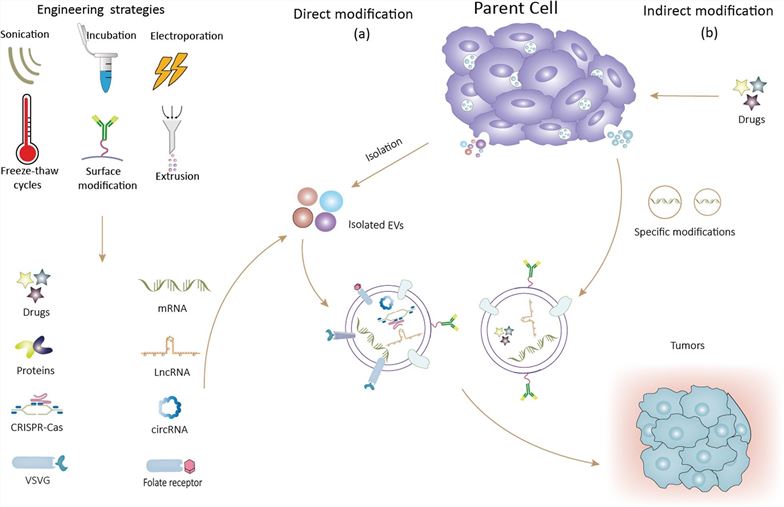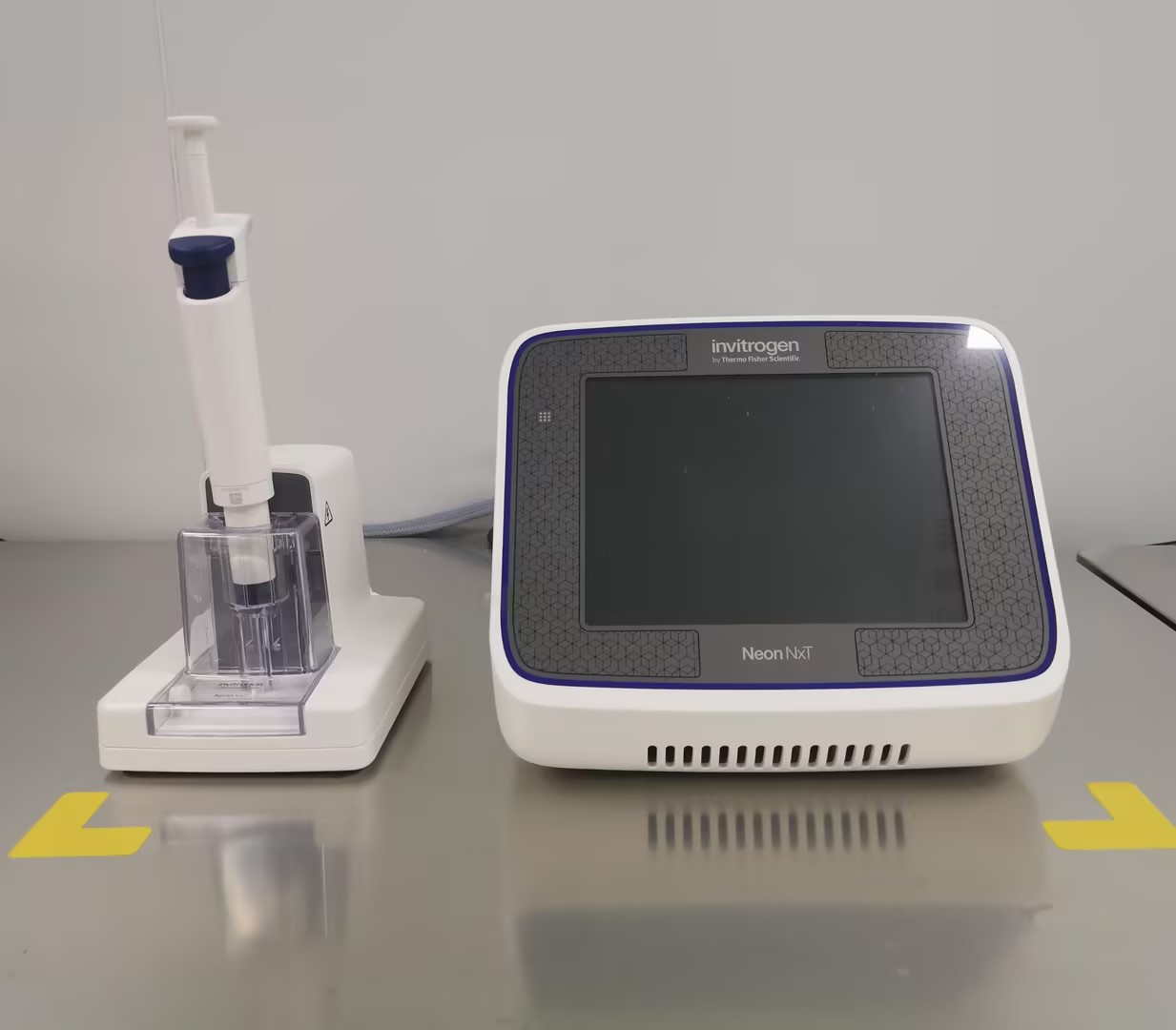Extracellular Vesicle Loading Service
Overview Services Features FAQs
Overview
Extracellular Vesicles as a Novel Delivery System
In recent years, with the in-depth study of drug carriers, extracellular vesicles (EVs) have been found to be a new type of biological media. EV can not only wrap endogenous substances, such as RNA, plasmid DNA, enzymes, and neurotransmitters but also load exogenous therapeutic drugs to exert its natural carrier function. The loading of EV can change the route and distribution of drugs into the human body, prevent the short-term degradation, inactivation, clearance, and immune response of drugs, control the release rate of drugs, and deliver drugs to target organs. Therefore, EVs have great application potential as drug carriers. At present, a large number of researchers have successfully used EVs to deliver a variety of substances, such as small molecule chemicals, LncRNA, siRNA, miRNA, mRNA, DNA, and proteins.
 Fig.1 Strategies for engineering extracellular vesicles (EVs).1,2
Fig.1 Strategies for engineering extracellular vesicles (EVs).1,2
Creative Biolabs has established a mature EV loading research platform through continuous optimization and can provide global customers with the most efficient EV loading services.
Services
Endogenous Loading Service for Extracellular Vesicle
The endogenous loading service of EV we provide is based on the genetic modification of parental cells. Specifically, we can construct plasmids with proteins or RNAs of interest by direct transfection to overexpress these drugs in parental cells. Drugs are then loaded into EV relying on the cells' own cargo sorting system. It is worth mentioning that drug loading with genetic engineering has less damage to the structure of EV and is suitable for loading high molecular weight drugs.
Exogenous Loading Service for Extracellular Vesicle
Exogenous loading of EV is the use of membrane penetration or other loading strategies to directly load drugs into EV. This method can load various therapeutic substances, including small-molecular-weight drugs, nucleic acids, proteins, and even nanomaterials, into EV. Compared with parental cell-based engineering approaches, exogenous loading techniques are less complex and have been widely used to develop novel drug delivery systems. The exogenous loading strategies of EV are mainly as follows.
-
Place EV in a solution containing drugs, and perforate the EV membrane through mechanical force or chemical reagents, so that drugs can diffuse into EV through small holes. This method is usually suitable for small-molecule drugs. Commonly used perforation methods include electroporation, ultrasound, freeze-thaw, etc.
-
Drugs and lipid molecules are first packaged into assemblies. These assemblies can be inserted into the phospholipid bilayer of EV through hydrophobicity, thereby obtaining EV with drugs on their surfaces.
-
First, the drugs and the lipid molecules with biotin are packaged into assemblies. These biotins can be indirectly intercalated on the surface of EV through hydrophobic interactions. The biotinylated EVs are then conjugated to the drug with streptavidin via bioconjugation.
 Fig.2. Electroconverter.
Fig.2. Electroconverter.
Features
-
Two Innovative Drug Loading Strategies
-
Enhanced Drug Encapsulation Efficiency
-
Precise and Controlled Loading
-
Stringent Quality Control and Validation
Creative Biolabs has been focusing on the potential of EV as novel drug delivery vehicles. We can provide one-stop EV research services for our customers from the exosome isolation and characterization of EV to the modification, EV profiling and functional research and verification of EV. If you are looking for the best carrier for your drug, please contact us with your ideas. Our professional team will formulate the best EV loading strategy for you to achieve your goals.
FAQs
Q: How do I choose between endogenous loading and exogenous loading for the drug loading process?
A: The choice between endogenous loading and exogenous loading depends on the type of target and the desired loading location. Endogenous loading is ideal for incorporating proteins, nucleic acids, or other molecules during vesicle formation to achieve loading on the EV surface. In contrast, exogenous loading is suitable for directly loading small molecules or RNA into the lumen of pre-isolated vesicles. If you are unsure about which loading method to use, our technical team can recommend the best loading strategy based on your project description.
Q: What type and quantity of samples should I provide for the drug loading process?
A: The sample requirements depend on the chosen loading strategy. For endogenous loading, you need to provide detailed information about the donor cell line or specific requirements for engineered cells. For exogenous loading, we require a larger volume of exosomes, at least 2 mL with a concentration of at least 1×10^11 particles/mL. We suggest contacting us to discuss your project in order to determine the most suitable minimum sample volume, ensuring the experiment proceeds smoothly while saving on samples.
Q: After the exosome loading is completed, what techniques can you use to confirm that the target molecule has indeed been loaded into the exosomes?
A: We employ strict quality control protocols to verify the efficiency and consistency of the loading process. These include vesicle characterization (size, zeta potential, and concentration), loading efficiency assessment, and stability testing. We provide the entire experimental procedure, detailed data, and analysis to help you fully understand the progress of your project.
References
-
Zhang, F.; et al. Application of engineered extracellular vesicles for targeted tumor therapy. Journal Of Biomedical Science. 2022, 29(1):14.
-
Distributed under Open Access license CC BY 4.0, without modification.
For Research Use Only. Cannot be used by patients.
Related Services:

 Fig.1 Strategies for engineering extracellular vesicles (EVs).1,2
Fig.1 Strategies for engineering extracellular vesicles (EVs).1,2
 Fig.2. Electroconverter.
Fig.2. Electroconverter.









